Building Community
Why (and How) I Teach This Way: An Educator Talks about Project-Based Learning
Topics

When educators design and create new schools, and live next gen learning themselves, they take the lead in growing next gen learning across the nation. Other educators don’t simply follow and adopt; next gen learning depends on personal and community agency—the will to own the change, fueled by the desire to learn from and with others. Networks and policy play important roles in enabling grassroots approaches to change.
Practitioner’s Guide to Next Gen Learning
An educator at San Diego's High Tech High shares the why's and how's of project-based learning in his Humanities classroom.
When visiting teachers first walk into innovative schools like the ones Next Generation Learning Challenges (NGLC) selects for Learning Excursions, they are often astonished by the quality of the student work they see. Phones suddenly emerge from pockets and purses to document and tweet out the posters, murals, models, robots, and other work products that line the walls and fill the classrooms. This was certainly the case during an NGLC Learning Excursion to San Diego in February 2019, which included a tour of High Tech High and the opportunity to speak with educators and students about their project-based learning (PBL) model.
Back on the bus to the hotel, however, visitors' conversations shifted, as they frequently do, from "Wow!" to "How?" Questions bubbled up about all of the effort—from both learners and their teachers—that goes into creating the amazing work they just witnessed.
For this edition of Friday Focus: Practitioner's Guide to Next Gen Learning, I spoke to one of the teachers we met on that visit, Rusty Walker, a Humanities teacher in his fourth year at High Tech High. In addition to describing his experiences with project-based learning, Rusty addressed many of the topics that educators working in more traditional models often raise, such as:
- Why PBL is a good fit for educators and learners
- What it takes to shift mindsets from traditional models to PBL
- What PBL looks like in practice
- How PBL prepares students for future success
What prompted you to teach in a project-based learning setting?
First of all, I don't think that project-based learning is the only real way to do education. You shouldn't be looking at it as a silver bullet to solve all of your problems. That being said, when we reflect on what really matters to us as educators and who is succeeding and who is not succeeding in our heavily standardized and test-driven environment, PBL, to me, is a much better and frankly more human way to do education. It's so much better than dropping huge amounts of knowledge, like unloading a truck, onto students period after period.
When we think about our own lives as adults and how the world works in the modern economy, it is about setting a goal and managing yourself to get to that goal. It's not about having a teacher there to scaffold in a hundred ways so that there's no real way to fail. It's critical that we allow students to have the experience of designing something for themselves and having the agency to carry it out. It is so rewarding when students can reflect on their growth and have a conversation about their goals, hopes, dreams, and how they've grown as human beings during their time with you.
What about High Tech High appeals to you as an educator?
When I first walked into the building, it felt different in terms of the amount and quality of the student work that was displayed in the hallways. Whenever I am in schools, I always talk to the students to get the lowdown from the people we are supposed to be serving. I was so impressed with students' ability to articulate what they were doing and why, how it was all connected, and the amount of power and freedom they had.
I realized that this is really what I want. I want students who challenge me and tell me, "I have this great idea and how can I make this happen?" My job then is to support and enable and facilitate instead of being a master of content, the one planning out every minute of every day.
There's an old saying that the one doing the work is doing the learning. At High Tech High it seemed like much of the burden was shifted off teachers and onto students and that this was a better preparation for life, where you have to be innovative and entrepreneurial and be your own boss. We really need people who can set goals and be creative and come up with ideas. Looking at the work and talking to the students, I could see myself spending a long time here and doing some awesome stuff.

Posters from the semester-long Exo Enterprises Space Colony Project line the windows of Rusty's Humanities classroom. (Courtesy of Rusty Walker)
High Tech High's PBL approach is very different from traditional models. How do you get others, including students, "on board" with this way of learning?
Students are actually the easiest because, honestly, there are very, very few students who enjoy the traditional model. Think about how many just go along, cooperate, and graduate—they don't know any other way. They may be "good students," but they are not passionate about what they are doing and couldn't articulate a good defense of why school looks the way it does. Students are easy to convince. "What? I can have more control over what I study? I can work socially and think about things that matter in my life and my community? I can be respected as a learner?" Who wouldn't sign up for that?
Teachers are the hardest population to convince, especially those who've been successful under the traditional model and have been doing it for a long time. To them, this might seem like yet another fad. A bunch of people come in to sell you something, and then it's going to go away in a few years because it wasn't the wonderful thing it was promised to be. The key to changing mindsets is to focus on the things about education that teachers would take away if they could—things that are imposed from above or from outside by people who aren't in the classroom but spend their time telling you what and how you should teach.
So what if we could get back to the heart of teaching, which is you and a group of people figuring out the world? PBL can enable that. You don't have to be the master of everything in your discipline. You need to convey your passion and your expertise in topics that will get your students excited and then make some space for them to investigate—the same way that you investigate what you are passionate about. Ultimately, it comes down to, "Can you create a space in your room that excites young people about learning about the world through your particular subject lens?"
Very few teachers went into education because they love giving tests or are married to the standards. If you have honest conversations with educators, the vast majority would jump at the chance for more autonomy, more freedom, more respect, more creativity, and getting back to the human part of education, which is you and a group of people investigating the world together.
Can you walk us through one of your projects to illustrate?
The eleventh graders did a space colony project with me and my partner Jeff Lohman, the biology teacher. The essential question was: Could you get 1000 people to live off the planet earth in a sustainable utopia?
Though there are hundreds of ways students could answer that question, there are some key phrases we unpack. One of these is sustainability, so Jeff talks about ecosystems and food, water, and oxygen for colonists. Waste disposal. Survival in this environment. All of that has implications for life on earth as well as in space. On the Humanities side, we ask, "What is a utopia? What do you think makes for a perfect society?" Then we impose some scientific limits. Could 1000 people actually survive on Mars with your ideas?
Once we introduce that challenge, students work in groups of four to do lots of brainstorming, investigation, researching their planet, and defining the problems to solve. Once they come up with an overarching concept, they pitch it to me and Jeff, saying something like, "We want a colony of vegan hippies on an ice moon" or "steampunk dirigibles floating in Venus." Sometimes, we might think, "OK, that sounds kind of crazy, but let's see if we can find a way that might work."
Daniel Pink writes about the three things that drive satisfaction at work: mastery, autonomy, and purpose. If you offer students the chance to master new skills and new ideas, the autonomy to make some decisions about what that looks like, and give them a purpose like, "we are trying to save humanity," you've got an inherently exciting idea for a project.
How do you hold students accountable for their learning throughout a semester-long project?
Students divide into roles and specialist jobs with specific deliverables within a larger project. This is a great strategy for maintaining accountability for a big project with lots of moving pieces. For example, all groups had an engineer who was responsible for designing the physical build of the colony using 3D modeling, like with Sketchup or Autocad.

A student in the "life scientist" role creates a survival suit as part of the space colony project. (Courtesy of Rusty Walker)
The life scientist was responsible for designing everything inside the colony that keeps people alive—the air, food, water, and waste systems. The social scientist designed the culture, government, and economy—how do we get the colony to be a cohesive whole and have a functioning society? The artist's job was to run a marketing campaign for the exhibition. Essentially, they were recruiting their parents, classmates, and the public to come to their colony as opposed to all the others.
One of the most powerful strategies is having students write their own contracts: "This is what I am responsible for, these are the deadlines I have to meet, and this is the shape my deliverables are going to take." We can then reference that contract every time we meet. One strategy I use a lot is to have them design their own rubric in a conference with me. We discuss, "What does a 5 out of 5 look like?" It then becomes a conversation about how you determine what acceptable evidence of their learning looks like.
If everyone is making custom stuff, or a project is going to look different in every group, it's hard to have a single standardized idea of what success looks like, and I think that's a good thing because you don't want people to just make cookie-cutter versions of what everyone else is doing. That's not personally meaningful to students. It's just checking boxes on a rubric to get a grade.
This project sounds like it takes a great deal of time and effort for both the educators and the learners—how do you make it work?
Every Friday during that semester, my teaching partner and I sat outside the room and called each group out one by one. We spent 20 or 30 minutes going through their work with a fine-toothed comb, looking at their products, giving feedback, asking questions. It's time-consuming and tiring but ultimately so worth it. You have to ask yourself, "How am I using my time?" If I am not giving everyone a lecture and then assessing them on how many questions they got correct on a worksheet, I can have individual meetings and be present in the moment with students and groups.
People in the workplace and college professors are noticing that there's a whole generation of very fragile students who have always gotten A's, but it's because they've been told exactly what to to do. They don't like ambiguity or uncertainty, and the thought of doing something less than perfectly is a crushing idea to them. The only way for students to learn skills like self-direction is by practicing them. Sometimes it does involve some wasted time and some tough lessons learned, but if you never let students fail and try again and grow, they don't get the chance to develop.
If you let yourself dream big and let students be co-designers, if they feel respected and heard, as well as challenged, they are going to have a great experience, because that's what every human wants.
Resources
- This folder of artifacts contains a sampling of the student-facing documents from Rusty and Jeff's Space Colony Project, including the calendar and syllabus, descriptions of the roles within the groups and their work products, and explanations of the various tasks like writing assignments, parameters for pitching the colony to the public, and a post-project reflection.
- These three exemplars of the colony book each group published demonstrate the quality of the work students produced and the range of approaches the groups chose for the project: Axis Mundi (dirigibles on Venus); McMars (a satirical look at a corporatist utopia), and UCM (United Colonials of the Moon).
- Other colony project work products included promotional posters, boarding passes, and a constitution.
- For more ideas and commentary on PBL, follow Rusty on Twitter @RWalkTheWalk.




